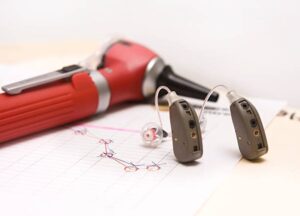If your baby receives a ‘refer’ result on the hearing screen, they must have a follow-up audiology assessment. A Child and Family Health Service nurse or specialist conducts this in the community.
This involves a pure tone audiometry test in a soundproof booth. This is the most basic form of hearing screening and measures your threshold or the quietest noise you can hear.
Why do I need to have a hearing test?
 There are many reasons why you may need to have a hearing test. Some people get tested regularly during regular doctor appointments, and others will have a screening as part of their ear, nose and throat (ENT) examinations. However, for most people, it is only when they notice problems with their hearing that they arrange a test. This could be because they are having trouble with specific sounds or have seen a general change in their quality of life.
There are many reasons why you may need to have a hearing test. Some people get tested regularly during regular doctor appointments, and others will have a screening as part of their ear, nose and throat (ENT) examinations. However, for most people, it is only when they notice problems with their hearing that they arrange a test. This could be because they are having trouble with specific sounds or have seen a general change in their quality of life.
For adults, hearing tests are often conducted every few years and are usually part of routine doctor appointments. This is because the risk of developing hearing loss rises significantly after middle age, and it is recommended that people have regular tests to ensure their hearing remains healthy as they age. For professional hearing test clinic Adelaide services, click here.
A hearing test is a simple and painless process requiring no special preparations. During a hearing test, the audiologist will ask you to sit in a soundproof booth and wear a pair of headphones. They will then play short tones of different pitches and volumes into one ear at a time, and you will be asked whether you can hear the sounds. This is then charted on a graph known as an audiogram, which helps pinpoint the severity of any hearing loss you may be experiencing.
Your audiologist will also look at the inside of your ears for signs of blockage, such as excessive ear wax or perforation of the eardrum. They will also test your ability to distinguish speech in quiet and noisy environments and carry on conversations with other people. If your audiologist finds you are suffering from hearing loss, they can recommend treatments such as hearing aids that can help improve your quality of life.
It is important to remember that not everyone who has hearing loss will need hearing aids, and you should always discuss the options with your audiologist. Depending on your lifestyle and needs, they can advise you on the best course of action. For professional hearing test clinic Adelaide services, click here.
Tympanometry
Tympanometry is a quick, painless, non-invasive test that evaluates the health of your middle ear space. It uses a small probe that emits a tone to measure the movement of your eardrum in response to changes in air pressure, evaluating whether fluid is present or there is a perforation in the eardrum. This is a standard diagnostic tool for children with suspected ear infections or problems with the Eustachian tube. Children need to remain still during the procedure and may need to be restrained for this reason. It is also advisable that they do not swallow or talk during the test as this can affect the air pressure in the ear canal, affecting the results.
During the tympanometry test, a probe emits a tone to stimulate the tympanic membrane and cause it to vibrate. The middle ear absorbs some of this sound, while some are reflected in the instrument. The device measures this response and plots it on a graph known as a tympanogram. This provides additional information regarding the middle ear that is not offered by audiometry alone, such as the ear canal volume (ECV), the compliance or static admittance of the middle ear, and the tympanometric peak pressure point.
A standard tympanogram curve has a mountain-like shape with a peak around the 0 data mark, meaning there is reasonable compliance in the middle ear. A curve with a smaller maximum height indicates that foreign matter, cerumen, or a lack of proper positioning of the eardrum is causing a poor seal and lower tympanometric peak pressure. A low peak pressure can also be caused by a perforation in the tympanic membrane or the ossicular chain dysfunction.
Performing tympanometry alone cannot confirm the presence of a conductive hearing loss or its cause; other tests like pure-tone and speech audiometry are often necessary to assess hearing sensitivity. Nevertheless, it is an essential test that helps to determine if the eardrum has moved, whether there is fluid behind it or a structural problem.
Speech Tests
A speech test, also known as a speech audiometry or a speech discrimination test, is one of the most valuable tests your hearing health clinic will carry out. This type of testing examines your ability to hear and recognise simple words at various levels of loudness.
You will listen to lists of single-syllable words, and the clinician will record your response. You may be asked to repeat part of the word and be allowed to respond at any level – it doesn’t have to be perfectly accurate! The test results will enable the clinician to determine your speech reception threshold (SRT). For professional hearing test clinic Adelaide services, click here.

